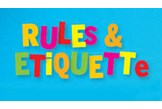Rules and Etiquette
Published: Last updated:
Owning up to your mistakes is only half the story…
Golf is one of the few sports where you are encouraged to call a penalty against yourself, but before you can do that, you need to have a sound understanding of the rules. Here’s a quick look at some fundamental rules and etiquette pointers, with a little help from our friends at the R&A.
|
FROM |
Most of us know you must play your tee shot from between, and not in front of, the tee markers. But did you know you can tee the ball up as far back as two club lengths behind the markers? | |
|
WATER |
These are marked by yellow or red stakes, and if your ball ends up in one of these you may play it from where it lies or take a penalty stroke. If your ball ends up in a water hazard (yellow stakes) and you wish to take a penalty stroke, drop your ball back as far as you like in a straight line from where it crossed the margin of the hazard, defi ned by the yellow stakes/line. You may also go back to where you last played from, with a penalty stroke. |
|
|
OUT OF |
If you think your ball may be lost or out of bounds, you should play another ball and identify this as a ‘provisional’. If you don’t fi nd the original ball, or it is out of bounds, you must continue to play the hole with the provisional ball. When adding up your score, count your ‘provisional’ tee shot as shot three. | |
|
MOVABLE |
If your ball lands next to a rake, for example, the rake should be moved so you can play your shot. If the ball moves while the rake is removed, the ball should be replaced in the original spot with no penalty stroke. | |
|
IMMOVABLE |
Free relief is available from immovable obstructions, such as an artifi cially surfaced road. Players can lift the ball and drop it within a club length of the nearest point of relief, but no closer to the hole. | |
|
YOUR BALL, |
When you and your opponent reach your balls in the fairway, you’re not sure which is yours. With the permission of your opponent, you can mark and lift a ball to identify it, then replace it. | |
|
GIVE HIM |
Make sure you give other players plenty of space when they are addressing the ball. Don’t stand too close or directly behind the ball. | |
|
ON THE GREEN |
It’s important not to stand on another golfer’s putting line. | |
|
REPAIRING |
One of the most annoying things in golf is walking up to your perfectly crunched tee shot only to fi nd the ball in a divot. It’s not hard: just collect any divot you make and replace it. | |
|
BUNKERS |
If your ball comes to rest in a bunker, or any hazard, you must not touch the sand or the water with the club or your hand until you take your shot. Basically, if you are in the sand, you must hover your club above it. | |
|
IMPROVING |
The ball must be played as it lies, and players are not allowed to improve the lie of the ball by pressing a club on the ground. This also includes moving, bending or breaking anything growing or fi xed to improve stance or swing. |

